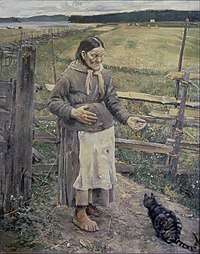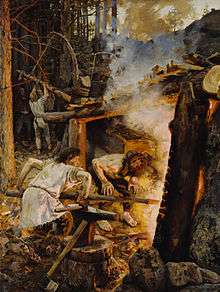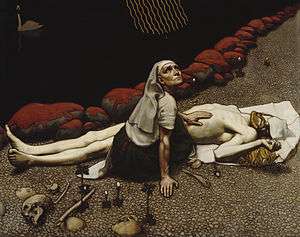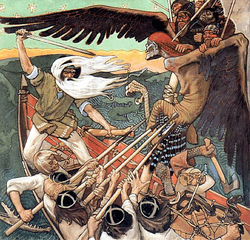Golden Age of Finnish Art
The Golden Age of Finnish Art coincided with the national awakening during the time 1880–1910. Themes during the period were often influenced by Kalevala and were visible in visual arts, literature, music and architecture of the time.[1] Central figure of the time was Akseli Gallen-Kallela. Other notable figures were Pekka Halonen, Albert Edelfelt, Jean Sibelius, Eino Leino, Helene Schjerfbeck, Eero Järnefelt, Emil Wikström and Eliel Saarinen.
Finnish art became known also in Europe at Paris 1900 World Fair, where Finnish pavilion was one of the most popular pavilions.[2]
Works
 Akseli Gallen-Kallela: Akka ja kissa, 1885.
Akseli Gallen-Kallela: Akka ja kissa, 1885. Akseli Gallen-Kallela: Sammon taonta, 1893.
Akseli Gallen-Kallela: Sammon taonta, 1893. Akseli Gallen-Kallela: Lemminkäisen äiti, 1897.
Akseli Gallen-Kallela: Lemminkäisen äiti, 1897. Akseli Gallen-Kallela: Kullervon kirous, 1899.
Akseli Gallen-Kallela: Kullervon kirous, 1899. Elin Danielson-Gambogi: Nuori Äiti, 1885.
Elin Danielson-Gambogi: Nuori Äiti, 1885. Elin Danielson-Gambogi: Äiti, 1893.
Elin Danielson-Gambogi: Äiti, 1893. Albert Edelfelt : Kuningatar Blanka, 1877.
Albert Edelfelt : Kuningatar Blanka, 1877.- Albert Edelfelt : Conveying the Child's Coffin ; A Child's Funeral, 1879.
References
- ↑ "Kalevala - Suomen taiteen kultakausi". Suomalaisen Kirjallisuuden Seura. Retrieved 2017-12-10.
- ↑ "The Golden Age of Finnish Art". Art Museum of Estonia. Retrieved 2017-12-10.
External links
| Wikimedia Commons has media related to Art of Finland. |
- The Golden Age of Finnish Art, Elina Ojala, University of Tampere.
This article is issued from
Wikipedia.
The text is licensed under Creative Commons - Attribution - Sharealike.
Additional terms may apply for the media files.
